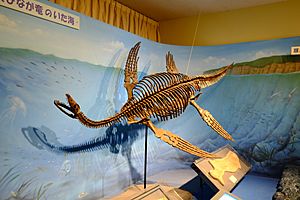Plesiosaurus facts for kids
Quick facts for kids Plesiosaurus |
|
|---|---|
 |
|
| Restored skeleton in Japan | |
| Scientific classification | |
| Genus: |
Plesiosaurus
|
| Species: |
dolichodeirus
|
Plesiosaurus was a fascinating ancient marine reptile. It lived in the oceans a very long time ago, during the Early Jurassic period. Imagine a creature with a long neck, a small head, and four large flippers like paddles! That was Plesiosaurus. Its name means "near lizard," and it was one of the first ancient reptiles discovered.
Contents
Discovering Plesiosaurus
The first Plesiosaurus fossil was found by a famous fossil hunter named Mary Anning. She discovered it in 1820-1821 along the 'Jurassic Coast' in England. This first find was missing its skull.
In 1823, Mary Anning found another Plesiosaurus fossil. This time, it was a complete skeleton, including the skull! A scientist named Reverend William Conybeare gave the creature its name, Plesiosaurus.
What Did Plesiosaurus Eat?
Plesiosaurus was a predator. This means it hunted other animals for food. It mostly ate fish and squid-like creatures called belemnites.
Plesiosaurus would swim through groups of fish. It used its long neck and sharp teeth to quickly snap them up. Its jaws could open very wide to catch its prey.
How Plesiosaurus Looked
Plesiosaurus was a typical member of its group, the plesiosaurs. It was about 3 to 5 metres (10 to 16 feet) long. That's about the length of a small car!
It had a short snout, but its jaws were strong. Inside its mouth, it had many cone-shaped teeth set in sockets. Its neck was quite long, and it had a short tail. The tail helped it steer in the water. Like all plesiosaurs, it used its four large, paddle-like flippers to swim through the ocean.
Was Plesiosaurus Warm or Cold-Blooded?
Scientists have wondered if ancient reptiles like Plesiosaurus were warm-blooded or cold-blooded. Warm-blooded animals, like us, keep a constant body temperature. Cold-blooded animals, like modern reptiles, rely on their environment to warm up.
Scientists from the University of Plymouth studied many diving animals. They looked at creatures from tiny insects to huge whales. They found that larger animals can hold their breath longer. This is because they can store more oxygen.
This difference was much bigger for warm-blooded animals than for cold-blooded ones. They thought this might be why whales grew so large. Since Plesiosaurus was also a large animal, like whales, these scientists believe it was more likely warm-blooded.
Other scientists also looked at chemicals in Plesiosaurus' teeth. They found clues that also suggested these ancient reptiles were warm-blooded.
Images for kids
-
Type specimen on display at the Natural History Museum
-
Tentatively referred specimen in Calgary
See also
 In Spanish: Plesiosaurus para niños
In Spanish: Plesiosaurus para niños








